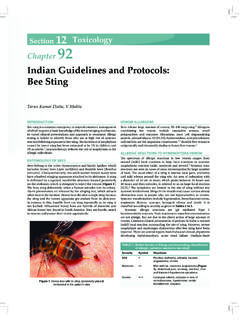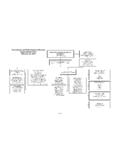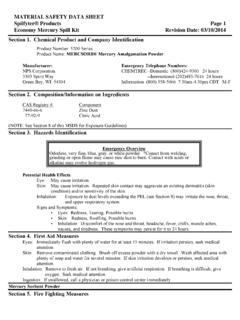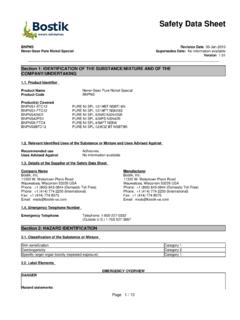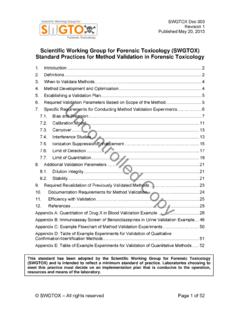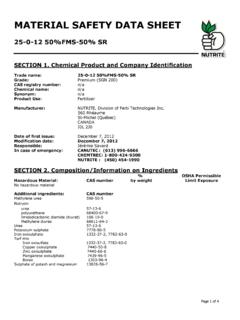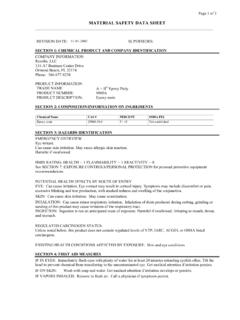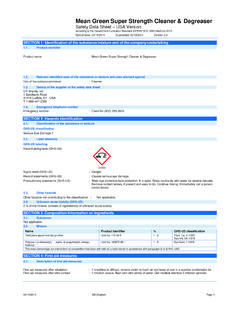Transcription of Material Safety Data Sheet Sealant – RTV – Acetoxy Cure
1 1 Material Safety data Sheet 0816OI, 0826OI Series RD PRO 100% Silicone Sealant RTV Acetoxy Cure MSDS No. 0080A, Rev. 4 Emergency Phone No. 800-535-5053 - INFOTRAC SECTION 1 PRODUCT NAME & MANUFACTURER INFORMATION PRODUCT NAME RD PRO 100% Silicone Sealant Industrial Grade RTV Acetoxy Cure MANUFACTURER S NAME & TELEPHONE NUMBER Red Devil, Inc. 918-825-5744 STREET ADDRESS 4175 Webb Street CITY / STATE / ZIP Pryor, Oklahoma 74361 SECTION 2 COMPOSITION / HAZARDOUS INGREDIENTS % TLV PEL UNITS PRODUCT CONSISTS OF: Ethyltriacetoxysilane (17689-77-9) < 6% NE NE Methyltriacetoxysilane ** (4253-34-3) < 6% 10 10 ppm Titanium Dioxide ** (13463-67-7) (In white & colors only) < 5% 10 15 mg/m3 Silica, amorphous ** (7631-86-9) < 13 20 20 mg/m3 Hydroxy-terminated Dimethyl Siloxane (70131-67-8) > 50 10 10 ppm Polydimethylsiloxane (63148-62-9) < 10 10 10 ppm Non-hazardous ingredients* > 10 NA NA *Unlisted ingredients are not considered hazardous under the OSHA Hazard Communication Standard (29 CFR ).
2 **Observe limits for acetic acid formed during curing on exposure to water or humid air. **Inhalation of particulates unlikely due to product s physical state. Calculated VOC: < 3%/wt (<40 g/L). CARB Compliance: Yes. Prop 65 Ingredients: None. SECTION 3 HAZARDS IDENTIFICATION PRIMARY ROUTE(S) OF ENTRY Skin Contact Skin Absorption Eye Contact Inhalation Ingestion EMERGENCY OVERVIEW Clear/opaque or colored paste. Harmful if swallowed or absorbed through skin. May cause eye & skin irritation. May cause nose, throat & respiratory tract irritation. EFFECTS OF OVEREXPOSURE Acute: (Eye) Direct contact may cause moderate irritation. (Skin) May cause moderate irritation. (Inhalation) Slight irritation to respiratory passages. (Oral) No significant effects expected from a single short-term exposure. Prolonged/Repeated Exposure: No known applicable information.
3 MEDICAL CONDITIONS AGGRAVATED BY EXPOSURE None known. SECTION 4 FIRST AID MEASURES SKIN CONTACT Wash w/ soap & water for @ least 15 minutes. Get medical attention if symptoms persist. Remove & wash contaminated clothing. EYE CONTACT Immediately flush w/ large quantities of water for @ least 15 minutes until irritation subsides. Get medical attention. INHALATION No first aid should be needed under normal use. Remove to fresh air if needed. INGESTION Not intended for ingestion. No first aid should be needed. Get medical attention if irritation persists. Treat according to person s condition & specifics of exposure. 2 SECTION 5 FIRE FIGHTING MEASURES FLAMMABLE Yes No EXTINGUISHING MEDIA Carbon Dioxide, Dry Chemical, Foam, Water Spray FLASHPOINT ( F) & METHOD > 212F (Closed Cup) UPPER EXPLOSIVE LIMIT (% BY VOLUME) NE LOWER EXPLOSIVE LIMIT (% BY VOLUME) NE AUTOIGNITION TEMPERTURE ( F) NE UNUSUAL FIRE & EXPLOSION HAZARDS None SPECIAL FIREFIGHTING PROCEDURES Wear self-contained breathing apparatus pressure demand (NIOSH approved or equivalent) & full protective gear.
4 Use water spray to cool exposed surfaces. Thermal breakdown of this product during fire or high heat conditions may evolve the following hazardous decomposition products: Silicon dioxide. Carbon oxides & traces of incompletely burned carbon compounds. Formaldehyde. SECTION 6 ACCIDENTAL RELEASE MEASURES PROCEDURES Wear proper protective equipment (Section 8). Use absorbent Material or scrape up dried Material & place in approved container. SECTION 7 HANDLING & STORAGE HANDLING PROCEDURES & EQUIPMENT Keep out of reach of children & pets. Do not take internally. Do not breathe vapors. Use w/ adequate ventilation. Product evolves acetic acid when exposed to water or humid air. Provide ventilation during use to control acetic acid within exposure guidelines or use appropriate respirator. Avoid eye contact. Avoid skin contact. STORAGE REQUIREMENTS Keep container closed & store away from water or moisture.
5 Avoid extreme heat or cold. Store away from oxidizing materials. When heated to temperatures above 300F in presence of air, product may form formaldehyde vapors. SECTION 8 EXPOSURE CONTROL / PERSONAL PROTECTION RESPIRATORY No respiratory protection should be needed. As Engineering Controls, Local & General Ventilation is recommended. Provide adequate ventilation to control exposures within guidelines of OSHA PEL: TWA 10 ppm & ACGIG TLV: TWA 10 ppm, STEL 15 ppm. Use respiratory protection if adequate local exhaust ventilation unavailable. OSHA respirator regulations 29 CFR should be followed, using NIOSH/MSHA approved respirators. Spills: Full face respirator. EYEWEAR Goggles or Safety glasses w/ side shields. Avoid eye contact. CLOTHING / GLOVES Nitrile rubber or butyl rubber gloves. Avoid skin contact. HYGENIC PRACTICES Remove & wash contaminated clothing before re-use.
6 Wash hands before breaks & @ end of workday. SECTION 9 PHYSICAL AND CHEMICAL PROPERTIES PHYSICAL STATE Viscous paste ODOR & APPEARANCE Clear or colored paste w/ acetic acid odor SPECIFIC GRAVITY Approximately to VAPOR DENSITY (AIR=1) NE EVAPORATION RATE NE BOILING RANGE ( F) NE pH NE SOLUBILITY IN WATER NE VAPOR PRESSURE (MM Hg) NE %/WT VOLATILE (TNV) NE SECTION 10 STABILITY AND REACTIVITY STABILITY Yes No Stable under normal conditions. INCOMPATABILITY Yes No Materials to Avoid: Water, moisture or humid air can cause hazardous vapors to form (Sec. 8). Oxidizing Material can cause a reaction. CONDITIONS TO AVOID None. HAZARDOUS POLYMERIZATION/HAZARDOUS DECOMPOSITION PRODUCTS Hazardous polymerization will not occur under normal conditions. Normal decomposition products, ie: COx, NOx. 3 SECTION 11 TOXICOLOGICAL INFORMATION / CARCINOGENICITY ACGIH No known applicable information.
7 This product does not contain carcinogens or greater) as defined by IARC, NTP or OSHA. OSHA No known applicable information. See above. IARC No known applicable information. See above. NTP No known applicable information. See above. data WITH POSSIBLE RELEVANCE TO HUMANS No known applicable information. See above. SECTION 12 ECOLOGICAL INFORMATION AQUATIC TOXICITY Complete information is not yet available. Ecotoxicity Classification Criteria: Hazard Parameters (LC50 or EC50) High Medium Low Acute Aquatic Toxicity mg/L <= 1 >1 & <= 100 >100 Acute Terrestrial Toxicity <= 100 >100 & <=2000 >2000 (Table adapted from Environmental Toxicology & Risk Assessment , ASTM STP 1179, p.
8 34, 1993) (Table can be used to classify the ecotoxicity of this product when ecotoxicity data is listed above. Please read the other information presented in the section concerning the overall ecological Safety of this Material . SECTION 13 DISPOSAL CONSIDERATIONS WASTE DISPOSAL EPA WASTE CODE IF DISCARDED (40 CFR ) Dispose of Material in accordance w/ Federal, State & Local regulations. None. RCRA Hazard Class (40 CFR 261): Not classified as a hazardous waste. State or local laws may impose additional regulatory requirements regarding disposal. SECTION 14 TRANSPORT INFORMATION SPECIAL SHIPPING INFORMATION DOT Road Shipment Information (49 CFR ): Not subject to DOT. Ocean Shipment (IMDG): Not subject to IMDG code. Air Shipment (IATA): Not subject to IATA regulations. SECTION 15 REGULATORY INFORMATION CERCLA SARA HAZARD CATEGORY Section 304 CERCLA: None.
9 Section 302 (Extremely Hazardous Substances): None. Section 312 (Hazard Class): Acute: Yes. Chronic: No. Fire: No. Pressure: No. Reactive: No. STATE REGS See Section 16. SARA 313 None present or none present in regulated quantities. TSCA All ingredients either on TSCA Inventory or exempt. SECTION 16 OTHER INFORMATION / SPECIAL PRECAUTIONS / LEGEND Prop 65 Ingredients: (Known to State of California to cause cancer) None. NJ Right-to-Know: (Top 5 Ingredients): Hydroxy-terminated Dimethyl Siloxane (70131-67-8), Silica, amorphous (7631-86-9), Methyltriacetoxysilane (4253-34-3), Ethyltriacetoxysilane (17689-77-9), Polydimethylsiloxane (63148-62-9). Pennsylvania Right-to-Know (Non-Haz @ >3%): Dimethyl siloxane, hydroxy-terminated (70131-67-8). Ingredients Known to State of California to cause birth defects or reproductive harm: None.
10 NFPA Profile: Health: 2, Flammability: 1, Reactivity: 0. INTERNATIONAL EMERGENCY NUMBER: 352-323-3500 - INFOTRAC LEGEND: NA Not Applicable, NE Not Established, UN Unavailable, VOC Volatile Organic Compound, PEL Permissible Exposure Limit, TLV Threshold Limit Value, STEL Short Term Exposure Limit, MSDS Material Safety data Sheet , ACGIH American Conference of Governmental Industrial Hygienists, SARA Superfund Amendments & Reauthorization Act of 1986, OSHA Occupational Safety & Health Administration, HMIS Hazardous Materials Identification System, NTP National Toxicology Program, CEIL Ceiling Exposure Limit, CASRN (CAS Number) Chemical Abstracts Service Registry Number, TSCA Toxic Substances Control Act, NFPA National Fire Protection Association. Reviewed By: _Larry G. Brandon_____ VP Technology & General Manager_____ January 12, 2012__ NAME TITLE DATE The information contained herein has been developed based upon currently available scientific data .

